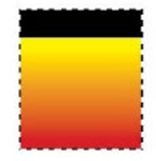In a recent decision, the Court of Appeals for the Federal Circuit held that color marks can be inherently distinctive when used on product packaging. On April 8, 2020, the Federal Circuit issued its opinion in In re: Forney Industries, Inc., vacating a refusal by the Trademark Trial and Appeal Board ("TTAB") to register a black, yellow, and red color mark applied to product packaging. In doing so, the Federal Circuit clarified prior Supreme Court precedent regarding colors and trade dress, and promulgated a new rule for analyzing color marks used for product packaging.
A. Background
Forney Industries, Inc. ("Forney"), a metalworking company that sells accessories and tools for welding and machining, applied to register the mark below for packaging for various welding and machining goods.

In its application, Forney identified the mark as a "color mark" and described the mark as follows: "The mark consists of a solid black stripe at the top. Below the solid black stripe is the color yellow which fades into the color red. These colors are located on the packaging and or labels." Because Forney sought to register the mark without showing secondary meaning, the examining attorney refused registration on the ground that the mark was not inherently distinctive. The TTAB affirmed the refusal, holding that (i) a color mark consisting of multiple colors can never be inherently distinctive and (ii) color marks applied to product packaging cannot be inherently distinctive in the absence of a well-defined peripheral shape or border. Forney appealed this decision and the Federal Circuit vacated and remanded the TTAB's decision. In doing so, the Court addressed both the TTAB's grounds for refusal and developed a new rule for determining whether color marks are distinctive.
B. History of Trade Dress Case Law
In order to understand the Court's reasoning, it is first helpful to review a trilogy of Supreme Court cases regarding color and trade dress. In Two Pesos, Inc. v. Taco Cabana, Inc., the Supreme Court held that inherently distinctive trade dress is entitled to protection without a showing of secondary meaning. 505 U.S. 763 (1992). However, the decision is silent on how to determine whether trade dress is inherently distinctive. Therefore, Two Pesos stands only for the proposition that trade dress can be inherently distinctive.
Three years later, in Qualitex Co. v. Jacobson Prod. Co., the Supreme Court held that a color could meet the legal requirements for trademark registration. 514 U.S. 159 (1995). In doing so, the Supreme Court found no "obvious theoretical objection to the use of color alone as a trademark, where that color has attained 'secondary meaning' and therefore identifies and distinguishes a particular brand (and thus indicates its 'source')." Id. at 163. Although Qualitex does not expressly require a showing of acquired distinctiveness before trade dress based on color alone is protectable, the decision seems to imply such a requirement.
Finally, in Wal-Mart Stores, Inc. v. Samara Brothers, Inc., the Supreme Court distinguished between two types of trade dress—product design and product packaging—and held that "[product] design, like color, is not inherently distinctive" because "product design almost invariably serves purposes other than source identification." 529 U.S. 205, 212 (2000). Product packaging, on the other hand, can be inherently distinctive because the very purpose of encasing a product in distinctive packaging is "most often to identify the source of the product." Id.
C. Federal Circuit Decision
With these three Supreme Court precedents before it, the Federal Circuit held that the TTAB erred in finding that a product packaging mark consisting of multiple colors is not capable of being inherently distinctive. While the Federal Circuit acknowledged that color is usually perceived as ornamentation, it nonetheless held that distinct color-based product packaging marks can be inherently distinctive.
The Federal Circuit's decision is based on the difference between product design trade dress and product packaging trade dress set out in Wal-Mart. Although the Supreme Court has held that trade dress applied to a product's design (as opposed to a product's packaging) can never be inherently distinctive, the Federal Circuit clarified that there is no such blanket holding regarding color trade dress for product packaging.
The Federal Circuit found that the color mark at issue in this case—a multi-color mark applied to product packaging—could be perceived by consumers to identify the source of the goods. The Federal Court also held that such marks can be inherently distinctive even in the absence of a distinctive peripheral shape or border.
Accordingly, the Federal Circuit vacated the TTAB's ruling and remanded the case for the TTAB to consider whether Forney's multi-color mark satisfies the criteria for inherent distinctiveness set out in Seabrook Foods, Inc. v. BarWell Foods Ltd., 568 F.2d 1342, 1344 (C.C.P.A. 1977). In doing so, the Federal Circuit instructed the TTAB to consider the following factors: "(1) whether the trade dress is a 'common' basic shape or design, (2) whether it is unique or unusual in the particular field, (3) whether it is a mere refinement of a commonly adopted and well-known form of ornamentation for a particular class of goods viewed by the public as a dress or ornamentation for the goods or, in applicable cases, (4) whether it is capable of creating a commercial impression distinct from the accompanying words."
In sum, this decision makes it easier for applicants to register distinct color marks for product packaging, as they will no longer be required to prove secondary meaning. However, it is still unclear what, if any, color marks will be deemed inherently distinctive under the factors set forth in Seabrook Foods.
Originally published 3 June, 2020
The content of this article is intended to provide a general guide to the subject matter. Specialist advice should be sought about your specific circumstances.

